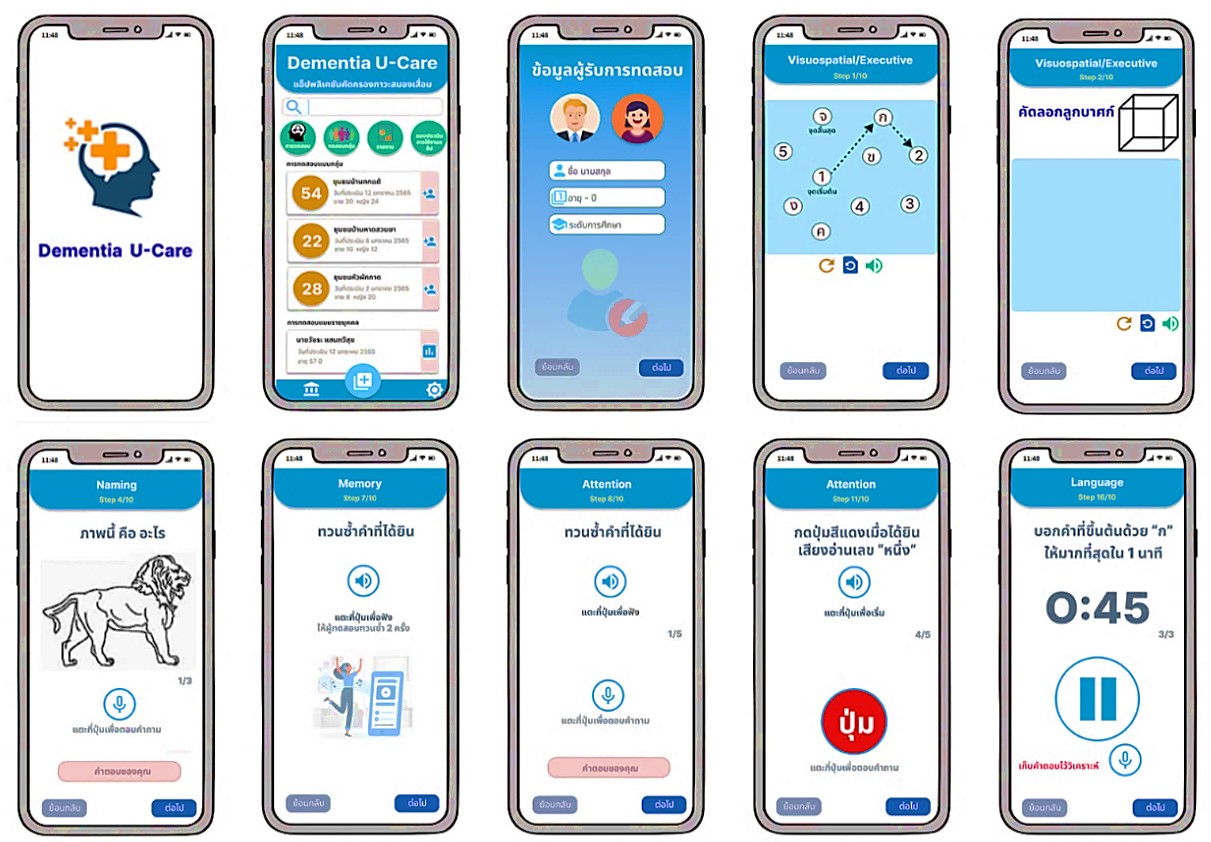การพัฒนาต้นแบบแอปพลิเคชันคัดกรองภาวะสมองเสื่อม
Main Article Content
บทคัดย่อ
งานวิจัยนี้มีวัตถุประสงค์เพื่อ 1) ศึกษากระบวนการทำงานและความต้องการของผู้ใช้งานแบบทดสอบ สมรรถภาพสมองในการคัดกรองภาวะสมองเสื่อม 2) ออกแบบประสบการณ์ผู้ใช้และส่วนต่อประสานผู้ใช้สำหรับการคัดกรองภาวะสมองเสื่อม 3) พัฒนาต้นแบบแอปพลิเคชันสำหรับการคัดกรองภาวะสมองเสื่อมในผู้สูงวัย และ 4) ประเมินความพึงพอใจผู้ใช้งานแอปพลิเคชัน กลุ่มตัวอย่างผู้ทดสอบใช้งาน ประกอบด้วย แพทย์ นักออกแบบและพัฒนาแอปพลิเคชัน ผู้สูงวัย และบุคคลทั่วไป จำนวน 23 คน ผลการวิจัยพบว่า 1) การเก็บข้อมูลใช้แบบสอบสำรวจที่มีรูปแบบคำถามและเกณฑ์วัดผลที่หลากหลายวิธีการ การจัดเก็บ วิเคราะห์ และสืบค้นย้อนหลังทำได้โดยยาก 2) การออกแบบระบบใช้กระบวนการคิดเชิงออกแบบ ประกอบด้วย 5 ขั้นตอน ได้แก่ การเข้าใจ การนิยาม การสร้างสรรค์ การสร้างต้นแบบ และการทดสอบ 3) ต้นแบบแอปพลิเคชันที่พัฒนาขึ้นใช้เทคนิคต่าง ๆ เพื่อช่วยในการเก็บข้อมูลได้สะดวกขึ้น ได้แก่ การประมวลภาพและการเรียนรู้เชิงลึก การจดจำและประมวลเสียงพูด การสัมผัสและท่าทางบนหน้าจอ การวิเคราะห์ตัวเลข และการจับเวลา โดยในการทำแบบทดสอบด้วยแอปพลิเคชันคัดกรองภาวะสมองเสื่อมยังคงต้องอาศัยผู้เชี่ยวชาญในการควบคุมและประเมินผลเพื่อให้ผู้รับการทดสอบสามารถปฏิบัติตามโพรโทคอลของเครื่องมือแบบทดสอบสมรรถภาพสมองได้อย่างถูกต้อง และ 4) ผลการประเมินความพึงพอใจของผู้ใช้งานแอปพลิเคชันคัดกรองภาวะสมองเสื่อมอยู่ในระดับ มากที่สุด มีค่าเฉลี่ยเท่ากับ 80.98 จากคะแนนเต็ม 100.00 โดยใช้ทฤษฎีมาตราส่วนการใช้งานระบบเป็นเครื่องมือในการประเมินผล
Article Details

อนุญาตภายใต้เงื่อนไข Creative Commons Attribution-NonCommercial-NoDerivatives 4.0 International License.
บทความที่ได้รับการตีพิมพ์ในวารสารฯ ท้ังในรูปแบบของรูปเล่มและอิเล็กทรอนิกส์เป็นลิขสิทธิ์ของวารสารฯ
เอกสารอ้างอิง
A. Natthamonworakul, “Strategy for Thai Aging Society: Establishment of the ASEAN Center for Active Aging and Innovation (ACAI) and the Ministry of Public Health's Policy on Aging 2022,” Journal of The Department of Medical Services, vol. 46, no. 4, pp. 5-9, 2021. (In Thai)
P. Anundilokrit, “Dementia,” Regional Health Promotion Center 9 Journal. Vol. 15, no. 37, pp. 392-398, 2021. (In Thai)
S. Hemrungrojn, S. Tangwongchai and T. Charoenboon, “Use of the Montreal Cognitive Assessment Thai version (MoCA) to Discriminate Amnestic Mild Cognitive Impairment from Alzheimer’s Disease and Healthy Controls: Machine Learning Results,” Dementia and Geriatric Cognitive Disorders, vol. 50, no. 2, pp. 183-194, 2021.
S. Zgonec, “Mobile Apps Supporting People with Dementia and Their Carers: Literature Review and Research Agenda,” IFAC-PapersOnLine, vol. 54, no. 13, pp. 663-68, 2021.
C. Yamagata, J. F. Coppola, M. Kowtko and S. Joyce, “Mobile App Development and Usability Research to Help Dementia and Alzheimer Patients,” In Proc. 2013 IEEE Long Island Systems, Applications and Technology Conference (LISAT), May. 2013, pp. 1-6.
D. Kwaunkwai, S. Suebpongsiri and N. Susri, “Questioning in Cases of Missing Persons with Dementia,” Journal of Criminology and Forensic Science, vol. 7, no. 2, pp. 151-162, 2021.
Ministry of Public Health, Handbook for the Development of Brain Potential of People with Impaired Brain Function in the Early Stages, Bangkok, Thailand: CyberPrint Group, 2016. (in Thai)
L. Setiyani and E. Tjandra, “UI/UX Design Model for Student Complaint Handling Application Using Design Thinking Method (Case Study: STMIK Rosma Karawang),” International Journal of Science, Technology & Management, vol. 3, no. 3, pp. 690-702, 2022.
C. Adhitya, R. Andreswari and P. F. Alam, “Analysis and Design of UI and UX Web-Based Application in Maiproyek Startup Using User Centered Design Method in Information System Program of Telkom University,” In Proc. IOP Conference Series: Materials Science and Engineering, Yogyakarta, Indonesia, Feb. 13-14, 2021.
J. Pacheco, S. Garbatov and M. Goulão, “Improving Collaboration Efficiency Between UX/UI Designers and Developers in a Low-Code Platform,” In 2021 ACM/IEEE International Conference on Model Driven Engineering Languages and Systems Companion (MODELS-C), Oct. 2021, pp. 138-147.
W. S. L. Nasution and P. Nusa, “UI/UX Design Web-Based Learning Application Using Design Thinking Method,” ARRUS Journal of Engineering and Technology, vol. 1, no. 1, pp. 18-27, 2021.
S. Kumprasert, et al., “Development of Data Management Program for Refilling Extemporaneous Preparation in Pediatric Patients at Outpatient Department of Maharaj Nakhon Chiangmai Hospital,” Thai Journal of Pharmacy Practice, vol. 14, no. 2, pp. 461-72, 2022.
J. Sauro. “5 Ways to Interpret a SUS Score.” MeasuringU. Accessed: Dec. 31, 2022. [Online]. Available: https://measuringu.com/interpret-sus-score
B. Ye, T. V. How, C. H. Chu and A. Mihailidi, “Dementia Care Apps for People with Dementia and Informal Caregivers: A Systematic Review Protocol,” Gerontology. vol. 67, no. 5, pp. 633-38, 2021.
K. Cheungsuvadee, P. Kumpa, P. Weerananthawet and P. Vorraboot, “Development of Screening Elderly Patients to Appoint Cataract Surgery Application,” Journal of Industrial Technology Ubon Ratchathani Rajabhat University. vol. 10, no. 2, pp. 113-24, 2020. (In Thai)


